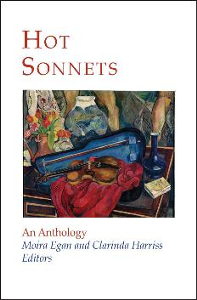Winter 2011
Table of Contents - Vol. VII, No. 4
Poetry Fiction Translations Reviews
Alan Reese
Hot Sonnets: An Anthology, edited by Moira Egan and Clarinda Harriss. ISBN-13: 978-0980099997. Entasis Press, 2011, 162 pages, paperback perfectbound, $14.00
Yowza! Please be advised to put on a pair of oven mitts when handling Hot Sonnets, the recently released anthology of erotic poems in a time honored and revered form. The editors, Moira Egan and Clarinda Harriss, have concocted a sizzling smorgasbord of sonnets to seduce the palate and titillate the senses. In the spirit of full disclosure, I must confess I am secretly married to both women in a bigamist’s utopia, well, at least in my own mind.
The anthology features 112 red hot poems by 57 sonneteers. The poems writhe with passion and lust and all the pleasure and pain that such emotions elicit. The poets span a contemporary range of age and time from Edna St. Vincent Millay, the acknowledged supreme mistress of the erotic sonnet, to Chloe Haralambous, a student at Columbia University.
Two editors more suited to pleasure readers with such a smart and sexy collection could not be found on the planet, and their complementary natures are evidenced in their introductions. Moira Egan lays before the reader a tongue-in-cheek overview of the form. She describes the purpose of the volume and the editors’ chosen voluntary restrictions in the selection process and teases with quotes from the works. It is a wonderful and masterful introduction that reflects her deep understanding of the form and the earthy humor that resides in her marrow. As for Clarinda Harriss, adjectives have yet to be invented to describe the light she radiates. She writes her introduction in a sonnet of apostrophe that displays her own clever, earthy, and wickedly libidinous tongue, dripping with knowledge and mischief. Harriss’s intro tells us as much as Egan’s in a more experiential fashion. Taken together they make a perfect whole.
The poems take on the hydra-headed monster of love in all of its more physical and sensual manifestations. They detail the war that wages in the human psyche as reason and passion, the head and the heart, face off in a no-holds-barred, winner-take-all death match, and they report on the fallout that occurs.
Filled with images of nature and anatomy, the lines swell in abundance with a cornucopia of ripe fruit, a menagerie of fertile animals, and a collection of body parts. If this were an erotic market, a hungry shopper might find any number of cleaved or phallic fruit dripping with juices and ready to burst open. Over at the raw bar in the next aisle, there is sushi to devour with greedy mouths and starving tongues and lips. Around the corner, the erotic pet store houses an assortment of birds ready to take flight and rise into the air, salmon spawning, bunnies ready to make more bunnies, swine, sex-starved cats, tadpoles, and an octopus. The body department, though, holds the record for most references including everything from the crown of the head to the feet and all erogenous zones worth exploring or to use for exploring in between. And you will even find a “loaf of bread” and “jug of wine” to go with your meal. This is, of course, all heated up with images and reference to fire and flames.
Sex and lust stroll hand in hand like lovers fresh from a romp or else headed to one and who meet along the way an array of allusions, classical and popular, from Snow White and Superman to poor Prufrock and Circe.
It is difficult to single out a particular poem because there are so many that are so fine. One of the strengths in the collection is its diversity. Even though they are unified by form, each poem is so unique in character, style, diction, and theme it is easy to forget that the poems that you are reading are all sonnets. There is a lot of play with the form in terms of line length and rhyme scheme which also contributes to the absence of monotony in the collection. Also included are examples of a crown of sonnets or sonnet corona in which the sonnets are linked together in theme and the final line of one sonnet becomes the first line of the next sonnet. In the strict definition, the line is repeated as the seven sonnets by Katherine Varnes nearly do, but Michael Cantor does it with rhyme, while Marilyn L. Taylor and Elizabeth M. Johnson use a repeated word or phrase to make the connection.
Eroticism is all about suggestion and expectation, a yearning for something to come, so to speak. This comes together most beautifully in David Bergman’s “In Nordstrom’s,” which, if you wrestled me to the floor, oiled up, naked Greco-Roman style, I might name as my favorite because it manages in such a quiet, gentle way to express a sexually charged atmosphere in the simple act of buying shoes. There are no overt sex acts or fertile animals present. The only anatomical features mentioned are face, skin, toes, and bones. Yet there is such desire and yearning coupled with painful realization that it creates an ache inside—an ache and longing that speaks more of want than any tongue tasting nipple might suggest.
But Hot Sonnets does not shy away from sex acts or the language of the bedroom and there is plenty of fellatio and fucking to go around, multiple times with multiple orgasms for hypersexual aficionados of erotic literature. Keeping both hands on the volume might be a herculean task for those individuals, but the oven mitts should help those prone to satyriasis to resist temptation although they make turning the pages a real ordeal.
© Alan Reese

